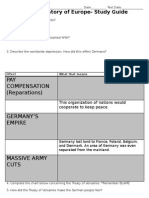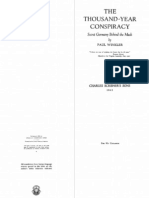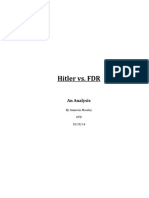0 ratings0% found this document useful (0 votes)
16 viewsThe world from 1914 to 1945
The world from 1914 to 1945
Uploaded by
LavanyaCopyright:
© All Rights Reserved
Available Formats
Download as PDF, TXT or read online from Scribd
The world from 1914 to 1945
The world from 1914 to 1945
Uploaded by
Lavanya0 ratings0% found this document useful (0 votes)
16 views3 pagesCopyright
© © All Rights Reserved
Available Formats
PDF, TXT or read online from Scribd
Share this document
Did you find this document useful?
Is this content inappropriate?
Copyright:
© All Rights Reserved
Available Formats
Download as PDF, TXT or read online from Scribd
Download as pdf or txt
0 ratings0% found this document useful (0 votes)
16 views3 pagesThe world from 1914 to 1945
The world from 1914 to 1945
Uploaded by
LavanyaCopyright:
© All Rights Reserved
Available Formats
Download as PDF, TXT or read online from Scribd
Download as pdf or txt
You are on page 1of 3
The world from 1914 to 1945
I.Choose the correct Answer
1. The First world war was also called ______________ .
a. Civil war b. Great war c. Sepoy Mutiny
2.The League of nations was formed after the ___________ .
a. Second world war b. First world war c. Gulf war
3. When did the first world war start?
a. July 1914 b. November 1918 c. May 1945
4. The leader of Germany during the second world war was __________ .
a. Benito Mussolini b. Adolf Hitler c. Winston Churchill
5.The Second world war ended in the year __________.
a. 1947 b. 1918 c.1945
II. Name the following
1. The place where the Germans kept Jews as prisoners. ____________.
2. The treaty that ended the First World War. _________________ .
3. Leader of the Nazi party. _______________.
4. The peace organisation formed after the Second World War._______ .
5.An organization formed after the First World War to maintain peace in the world
war.____________
III. Answer the following?
1. What is Holocaust?
2 .Name the weapons used in First World War and Second World War.
3 .How was Germany punished after the First World War?
IV. Look at the picture of U- boat. Answer the following
1. What were U-boat?
2. In which war were the u-boats first used?
3. Which Power used U-Boats in the war-Allied powers
or the Central powers?
The World from 1914 to 1945 - Extra Questions
1. Short Answer Questions (2 marks)
1. What was the cause of World War I?
2. Name the two main alliances during World War I.
3. Who were the Central Powers during World War I?
4. What event led to the start of World War II?
5. Who were the Allied Powers during World War II?
6. What was the role of women during World War I and World War II?
7. What was the League of Nations, and what was its purpose?
8. Who was Adolf Hitler, and what role did he play in World War II?
9. What was the Treaty of Versailles?
10. Name two important leaders of the Allied Powers during World War II.
2. Long Answer Questions (5 marks)
1. Explain the main causes of World War I. How did the war impact countries
around the world?
2. Describe the events leading to the outbreak of World War II. What were the
effects of the war on Europe?
3. Explain the significance of the Treaty of Versailles. How did it contribute to the
start of World War II?
4. What was the role of the United States in World War II? How did their
involvement change the course of the war?
5. Discuss the impact of World War I on the countries of Europe, particularly in
terms of their economy and society.
6. Who were the key figures in the Axis Powers during World War II? What were
their goals?
7. What were the main battles of World War II? Describe one major battle and its
outcome.
8. Explain how the world changed after World War II. What new international
organizations were formed, and why?
9. Describe the events of the Great Depression. How did it affect the global
economy and the lives of people worldwide?
10. What were the major technological advancements during World War II, and
how did they change the future?
4. Fill in the Blanks (1 mark each)
1. World War I began in the year __________.
2. The __________ was formed after World War I to maintain peace.
3. The Axis Powers were led by __________, __________, and __________.
4. The leader of the United Kingdom during World War II was __________.
5. The __________ was the alliance of countries that fought against the Axis
Powers in World War II.
6. The attack on __________ led to the United States entering World War II.
7. The main battle fought between Germany and the Soviet Union was the Battle
of __________.
8. The war between the Allies and the Axis Powers is known as __________.
9. Adolf Hitler was the leader of __________.
10. The __________ was signed in 1919 to end World War I.
5. True or False (1 mark each)
1. World War II lasted from 1939 to 1945. (True/False)
2. The Central Powers won World War I. (True/False)
3. The United States was not involved in World War I. (True/False)
4. The Battle of Stalingrad was a turning point in World War II. (True/False)
5. The Soviet Union was part of the Axis Powers. (True/False)
6. The Holocaust occurred during World War I. (True/False)
7. The League of Nations was successful in preventing World War II.
8. The dropping of atomic bombs on Hiroshima and Nagasaki led to the
end of World War II. (True/False)
9. The Great Depression began after World War II. (True/False)
10. Germany was divided into two parts after World War II. (True/False)
6. Multiple Choice Questions (1 mark each)
1. Which country was not a part of the Allied Powers in World War II?
a) United States b) Germany c) Soviet Union d) United Kingdom
2. Who was the leader of Germany during World War II?
a) Benito Mussolini b) Franklin D. Roosevelt c) Winston Churchill d) Adolf
Hitler
3. Which battle is considered the turning point of World War II in the
Pacific?
a) Battle of Britain b) Battle of Midway c) Battle of Stalingrad d) D-Day
4. What year did World War I end?
a) 1912 b) 1915 c) 1918 d) 1920
5. What was the main reason for the start of the Great Depression?
a) The rise of communism b) Economic instability and stock market crash
c) Political instability in Europe d) The rise of fascism
6. The United Nations was formed after which event?
a) World War I b) The Russian Revolution
c) World War II d) The Cold War
7. Which event triggered the start of World War II? a) The invasion of Poland
by Germany
b) The attack on Pearl Harbor
c) The signing of the Treaty of Versailles
d) The D-Day invasion
8. Which of the following countries was not part of the Axis Powers?
a) Italy b) Japan c) Germany d) France
9. Which leader was in charge of the Soviet Union during World War II?
a) Nikita Khrushchev b) Leon Trotsky
c) Joseph Stalin d) Vladimir Lenin
10. What was the purpose of the Nuremberg Trials after World War II?
a) To hold Nazi leaders accountable for war crimes b) To form the United
Nations
c) To discuss the division of Germany d) To negotiate peace terms with Japan
You might also like
- History Mock Paper s3 1Document14 pagesHistory Mock Paper s3 1N100% (1)
- International GCSE History Scheme of WorkDocument18 pagesInternational GCSE History Scheme of WorkKayla YEUNG [10N17]100% (1)
- History Mock Paper s3 2Document15 pagesHistory Mock Paper s3 2N0% (1)
- PreassessmentDocument2 pagesPreassessmentapi-2356709330% (1)
- History QuestionsDocument10 pagesHistory QuestionsRhea AgrawalNo ratings yet
- 10th Book Back One Mark EMDocument19 pages10th Book Back One Mark EMeshwariNo ratings yet
- Unit 3 Waw Study GuideDocument2 pagesUnit 3 Waw Study Guideapi-309710992No ratings yet
- MCQs of WW2Document2 pagesMCQs of WW2ﹺ ﹺ ﹺ ﹺ50% (2)
- Phases of the Second World War ExercisesDocument2 pagesPhases of the Second World War Exercisesalbadediegocallejon08No ratings yet
- PWS 18 - NazismDocument3 pagesPWS 18 - Nazismkeerthichalla22No ratings yet
- SSE Answer SheetDocument9 pagesSSE Answer Sheetammrm7md258No ratings yet
- Namma Kalvi 10th Social Science 1 Mark Questions For Practice em 215071Document34 pagesNamma Kalvi 10th Social Science 1 Mark Questions For Practice em 215071ASHOK THE EDITORNo ratings yet
- Unit 2. Activities WWI and Russian RevolutionDocument7 pagesUnit 2. Activities WWI and Russian RevolutionrubingamergamerNo ratings yet
- Bidhannagar Municipal School Class-V, Subject - History Medium - EnglishDocument6 pagesBidhannagar Municipal School Class-V, Subject - History Medium - EnglishSohailRanaNo ratings yet
- History Revision Worksheet 1Document4 pagesHistory Revision Worksheet 1funflarefactsNo ratings yet
- 10 Ss Mini Material em Karur - 2022-23Document123 pages10 Ss Mini Material em Karur - 2022-23santhoshsontosh51No ratings yet
- 10th Book Back One Mark EM Edit PDFDocument19 pages10th Book Back One Mark EM Edit PDFeshwariNo ratings yet
- Ushistory WwiDocument3 pagesUshistory Wwiapi-324796495No ratings yet
- AP8 FOURTH PeriodicalDocument5 pagesAP8 FOURTH Periodicalchamine c. quinonesNo ratings yet
- WWII+Student+Guide 020621Document3 pagesWWII+Student+Guide 020621amychanesposaamajikiuwuNo ratings yet
- Unit Assessment ProjectDocument8 pagesUnit Assessment Projectapi-643288346No ratings yet
- Test Review #5 Random Trivia: TH TH THDocument4 pagesTest Review #5 Random Trivia: TH TH THT. McCaskillNo ratings yet
- Unit 2b Study Guide 2015-2016Document3 pagesUnit 2b Study Guide 2015-2016api-261510671No ratings yet
- Guia HistoriaDocument6 pagesGuia Historiasammyyestrada06No ratings yet
- Nazi QuizDocument4 pagesNazi QuizSubbu LakshmiNo ratings yet
- 12.the Second World WarDocument10 pages12.the Second World Warayushsardesai9No ratings yet
- Book-1 Political Science MCQs For Term 1 (EM)Document15 pagesBook-1 Political Science MCQs For Term 1 (EM)Garima ShahNo ratings yet
- One Words SocialDocument8 pagesOne Words SocialM.K VARUN KUMARNo ratings yet
- WWII WebQuest 2019Document4 pagesWWII WebQuest 2019Kevin KalfassNo ratings yet
- WWII Pre Course AssessmentDocument4 pagesWWII Pre Course AssessmentMark DarketNo ratings yet
- Spring 2024 Final Exam ReviewDocument6 pagesSpring 2024 Final Exam Revieworange cNo ratings yet
- World War II Notes - Americas History Chapter 24Document41 pagesWorld War II Notes - Americas History Chapter 24api-326102962No ratings yet
- Chapter 26 Study GuideDocument7 pagesChapter 26 Study GuideSai AlamNo ratings yet
- Test Paper For Canadian History Grade 11Document5 pagesTest Paper For Canadian History Grade 11Reynasol ButiongNo ratings yet
- World WarIITestReviewDocument3 pagesWorld WarIITestReviewGreyJumperNo ratings yet
- CLass 8 MID Term History 2023Document3 pagesCLass 8 MID Term History 2023www.rachelkennedy500No ratings yet
- WWII Test: 80 Points Multiple Choice: (2 Pts. Each)Document9 pagesWWII Test: 80 Points Multiple Choice: (2 Pts. Each)Anonymous eqmoQONo ratings yet
- Form 5 World History Term I Examination SyllabusDocument5 pagesForm 5 World History Term I Examination SyllabusEeyore Felix100% (1)
- World War II Unit TestDocument4 pagesWorld War II Unit TestzoeNo ratings yet
- Answer Each of The Following Questions in The Space ProvidedDocument2 pagesAnswer Each of The Following Questions in The Space ProvidedCharles AbelNo ratings yet
- World War 2 - Background Information Web QuestDocument1 pageWorld War 2 - Background Information Web QuestNarasimha DvlNo ratings yet
- WWII EssentialsDocument2 pagesWWII EssentialsMrKelleyNo ratings yet
- 03-02-2023-1675413194-SS - QR Code EMDocument21 pages03-02-2023-1675413194-SS - QR Code EMS.Sampath Chemistry Ghss GurubarapalliNo ratings yet
- World War II PresentationDocument23 pagesWorld War II Presentationasim.ansar.coNo ratings yet
- Essay Questions Cold War History p4Document8 pagesEssay Questions Cold War History p4dhara g shahNo ratings yet
- Worksheet 1Document6 pagesWorksheet 1sharmabalmukund273No ratings yet
- Performance Task 2 - ACADocument5 pagesPerformance Task 2 - ACAARCIE CLEMENCE ACANo ratings yet
- Revision Exam Sem 2 Y10 HistoryDocument4 pagesRevision Exam Sem 2 Y10 HistorypetrebichescuNo ratings yet
- 10Th Social Science English Medium 2023-24Document43 pages10Th Social Science English Medium 2023-24ontamil2020No ratings yet
- Grade 6-Social Notes - Unit-2.8-2.14Document4 pagesGrade 6-Social Notes - Unit-2.8-2.14elsaalphonse6No ratings yet
- HistoryDocument8 pagesHistoryaNo ratings yet
- VIII History HO 3Document2 pagesVIII History HO 3aditiroy201208No ratings yet
- Questions Bank - 2nd TrimesterDocument6 pagesQuestions Bank - 2nd Trimesteraam.anasamNo ratings yet
- Kmfy8Yrhgedqrw0Cspveqka4/Copy: Please Don'T Hesitate To Contact Me If You Have Questions or Concern!Document4 pagesKmfy8Yrhgedqrw0Cspveqka4/Copy: Please Don'T Hesitate To Contact Me If You Have Questions or Concern!sebi07mexNo ratings yet
- The Century Americas Time Best YearsDocument2 pagesThe Century Americas Time Best Yearsapi-327140658No ratings yet
- Ushistory WwiiDocument3 pagesUshistory Wwiiapi-324796495No ratings yet
- Wwii Study GuideDocument2 pagesWwii Study GuideEduardo BorjaNo ratings yet
- World WarDocument8 pagesWorld Warjaydenrodrigues445No ratings yet
- Wwii TestDocument7 pagesWwii Testapi-356491391100% (1)
- WorldwariiwebquestwithkeyDocument12 pagesWorldwariiwebquestwithkeyAlexandra oncapNo ratings yet
- The Cold War: Chronicling the Most Significant Events from The Cold War for KidsFrom EverandThe Cold War: Chronicling the Most Significant Events from The Cold War for KidsNo ratings yet
- The PianistDocument15 pagesThe Pianistflicts2009No ratings yet
- The Thousand-Year Conspiracy - Secret Germany Behind The Mask by Paul Wrinkler P1Document109 pagesThe Thousand-Year Conspiracy - Secret Germany Behind The Mask by Paul Wrinkler P1Maximus100% (1)
- PowerPoint The HolocaustDocument389 pagesPowerPoint The HolocaustOana MotohoiNo ratings yet
- Spring 2024 Final Exam ReviewDocument6 pagesSpring 2024 Final Exam Revieworange cNo ratings yet
- Wwii Test 7th GradeDocument3 pagesWwii Test 7th Gradeapi-273006303No ratings yet
- Mons Vaticanus: Sovereign Satanic City State of The Dead, Nazi-Popes & Whore of BabylonDocument22 pagesMons Vaticanus: Sovereign Satanic City State of The Dead, Nazi-Popes & Whore of BabylonITK7100% (3)
- A3 Development of Dictatorship Germany 1918-1945Document12 pagesA3 Development of Dictatorship Germany 1918-1945fadum099100% (1)
- 9 Social SP Sa1 3Document12 pages9 Social SP Sa1 3ANUPAM PRASADNo ratings yet
- Social Studies 6th Grade Europe Teacher NotesDocument31 pagesSocial Studies 6th Grade Europe Teacher Notes랜드지구No ratings yet
- Adolf HitlerDocument23 pagesAdolf HitlerHairul IzzuddinNo ratings yet
- Winters Bullet (Excerpt)Document7 pagesWinters Bullet (Excerpt)I Read YANo ratings yet
- Landmark Speeches of National Socialism - Randall L. Bytwerk - Landmark Speeches (Paperback), 2008 - Texas A University Press - 9781603440158 - Anna's ArchiveDocument137 pagesLandmark Speeches of National Socialism - Randall L. Bytwerk - Landmark Speeches (Paperback), 2008 - Texas A University Press - 9781603440158 - Anna's Archivebmashina1488No ratings yet
- SST Class IX Notes PDFDocument10 pagesSST Class IX Notes PDFKishlay AnandNo ratings yet
- Social Studies 20 1 Position Paper PDFDocument6 pagesSocial Studies 20 1 Position Paper PDFkeith castillejosNo ratings yet
- Rare Photographs of HitlerDocument48 pagesRare Photographs of HitlerMushtaq M.Chinoy100% (2)
- Fourth ReichDocument11 pagesFourth ReichMarcosMeinerz0% (1)
- CEM - Paper 2 - Hitler vs. FDRDocument15 pagesCEM - Paper 2 - Hitler vs. FDRaidenNo ratings yet
- KWL Chart: World War Ii: K: What I Already W: What I Want To L: What I HaveDocument2 pagesKWL Chart: World War Ii: K: What I Already W: What I Want To L: What I HaveRayhonna WalkerNo ratings yet
- Who Voted For The Nazi?Document6 pagesWho Voted For The Nazi?Hannah LohNo ratings yet
- Cordell Hull - The Memoirs of Cordell Hull - Volume 2. 2 (1948)Document904 pagesCordell Hull - The Memoirs of Cordell Hull - Volume 2. 2 (1948)Bartosz LubczonokNo ratings yet
- Siege of LeningradDocument12 pagesSiege of LeningradNicolinaSurelNo ratings yet
- Nazi Consolidation of PowerDocument6 pagesNazi Consolidation of PowerWill TeeceNo ratings yet
- 10th Social Science - EM - 1 - HISTORYDocument45 pages10th Social Science - EM - 1 - HISTORY023]023No ratings yet
- Timeline of Key Events - Paper 1 - The Move To Global War Italy and Germany 1933-1940Document10 pagesTimeline of Key Events - Paper 1 - The Move To Global War Italy and Germany 1933-1940victormwongNo ratings yet
- Nazi Germany - Consolidationg Maintaining PowerDocument56 pagesNazi Germany - Consolidationg Maintaining PowerStepan KoltsovNo ratings yet
- 10 STD - SOCIAL SCIENCE - Additional QuestionsDocument32 pages10 STD - SOCIAL SCIENCE - Additional QuestionsSangeetha VijaiNo ratings yet
- Pax Germanica in The Future-HistoricalDocument2 pagesPax Germanica in The Future-HistoricalGiuseppe De CorsoNo ratings yet
- George Lincoln RockwellDocument32 pagesGeorge Lincoln RockwellrayaroburNo ratings yet
- GRADE 9 FULL Worksheet-1Document58 pagesGRADE 9 FULL Worksheet-1VACHAN L A100% (1)
























































































